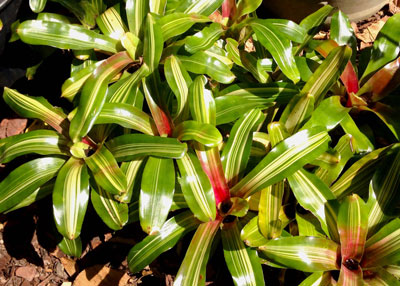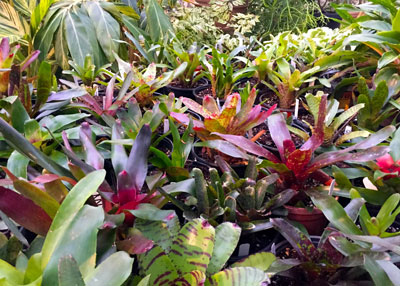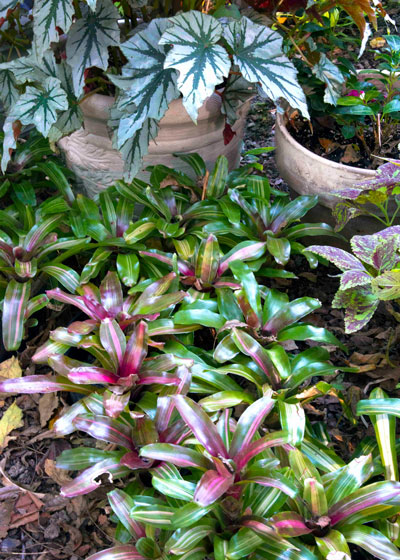Out of the Greenhouse and Into the Gardens
If you have a little corner in your garden where you’re looking for something a bit out of the ordinary, you might do what I did.

This mature plant has been with me for 20 years. I’ve harvested dozens of plants in the process.
After growing Neoregelias (one particular genus of bromeliads) for many years, I decided to try sinking them down into one of my beds so that they’d look like they were growing there. One of my main goals was to outsmart the armadillos. They hate bromeliads because of their tough and toothed leaves. But I leave them in pots so I can pull them up in late fall and whisk them back into the greenhouse when winter approaches.

My first exposure to this one type of bromeliad was perhaps 25 years ago when I bought a creamy white variegated type at a cactus and succulent sale. It kept sending out new offshoots (“pups”) until I finally potted it up into an old wire basket. It’s been a star of its corner ever since.
From that one plant I kept buying more. I found that the category I really wanted to collect was the “rhizomatous” types. Those are the ones that send out horizontal side shoots that form additional plants, and the genus Neoregelia was my pick of them all.
And then I found eBay. I started with 5 or 8 plants and I soon had 200. I don’t want to say that obsessive behavior runs in my family, but in the off chance that it might, I probably carry the gene.
You can find bromeliads from Texas nurseries and bromeliad enthusiasts. However, since I was looking for really specific dwarf, rhizamatous types of Neoregelias, I had to be a lot more selective, and the best source that I found was Mark Hertz in New Orleans (http://mabromeliads.com). I bought close to 200 varieties from Mark’s eBay listings, and I couldn’t have been happier with the selection and his incredible quality.

I received these plants from Mark Hertz one day and we potted them up the next morning. They took right off and have just gotten better.

Those same plants grew this much in just one year. I guess you can see why I’m fond of bromeliads.
How I use my bromeliads…
Here’s how I show them to best advantage:
• Morning sun until about 10, or light filtered sun during the day. They need the sun to produce their most vibrant colors. (See the photos on Mark’s eBay listings!) But too much sun and they will bleach to a parchment-like look.
• Sink the pots flush with the ground. I use a sharpshooter spade to dig holes the perfect size. I like to have my plants overlap slightly so I can’t see the pot rims.
• Sprinkle finely ground pine bark mulch between the plants to tie it all together visually. (Wear gloves – bromeliad leaves have teeth.)
• Water with a water breaker from above. Sure you want to keep their potting soil moist, but bromeliads also take water in through the “vases” made by their rolled-up leaves.
• Don’t overdo it on the fertilizer. Give them too much nitrogen and you’ll lose their rich colors as they shade to green instead.
• When temperatures begin to drop near freezing, make provision for bringing your bromeliads into a greenhouse or sunroom.

If you didn’t know these plants are actually growing in pots you’d have a hard time telling it. I’m really pleased with this look in our landscape. Perhaps it will work for you, too.
